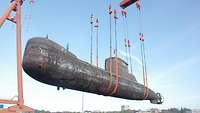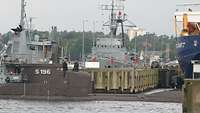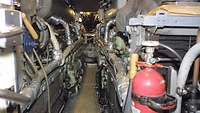Ex-U17 to be lent to Technik Museum in Sinsheim


What seems simple in principle, required complex planning: In February 2023, the Federal Office of Bundeswehr Equipment, Information Technology and In-Service Support and the automobile and engineering museum association Auto-Technik-Museum e. V. ("Technik Museum") in Sinsheim, Baden-Württemberg, concluded a loan contract to exhibit the former submarine U17, or "ex-U17" for short.

The journey to the exhibition begins
Bundeswehr/Klaas Hartmann-MoritzenIn addition to the extensive demilitarisation, it was required to process a long list of hazardous substances that had to be removed before the submarine was clear to start its journey over the North Sea and the Rhine river to Speyer and then to Sinsheim.
Due to the great demand for high-quality steel parts, the majority of 206 and later 206A class submarines were sold for disposal.
For example, submarines U15, U16 and U18 were sold for disposal via the VEBEGVerwertungsgesellschaft für besatzungseigene Güter GmbHGesellschaft mit beschränkter Haftung company. A smaller number of submarines of this class was sold to other nations for further use. The submarines U23 and U24 were taken over by the Colombian armed forces, where they help contain oil spills and fight cocaine smuggling.
With the ex-U17, only one submarine of this class will be on display soon.

Ex-U17 leaves the port of Eckernförde (2006)
Bundeswehr/Matthias DörendahlIn terms of military historical exhibitions, the Wehrtechnische Studiensammlung (WTSWehrtechnische Studiensammlung), which is the collection of military equipment of the Federal Office of Bundeswehr Equipment, Information Technology and In-Service Support, maintains a long-standing cooperation with the Technik Museum. The Speyer site of the Technik Museum has already been given the 205 class submarine ex-U9 as a loan. In December 2017, the museum showed interest to also expand its Sinsheim exhibition by a submarine. After then Minister of Defence Ursula von der Leyen had given her approval, extensive planning for the loan started at the WTSWehrtechnische Studiensammlung until finally, ex-U17 was identified as a suitable exhibit. This 206A class submarine was best preserved and therefore eligible for lending it to the Technik Museum.
While the loan itself is free of charge, it still involves some costs for the museum, which must fulfill some prerequisites before the "precious piece" can take its new place. In accordance with the loan conditions, the museum, for example, has to pay for the insurance and certain work such as demilitarisation and transport once the submarine has been handed over physically.
Loan contracts have a long history that begins in the period of Roman law. Even at that time, the loan or loan item was handed over free of charge. And this practice continues today.
A loan contract between a lender and a borrower regulates the lending of a loan item for a limited period of time. It also contains a description of the loan item, which must always be a physical object. It is not possible to borrow or lend rights. The contract also specifies the return of the loan item and the liability.
Ex-U17 was commissioned into the Navy on 28 November 1973 and was mainly employed in the North and Baltic Sea areas until it was taken out of service on 14 October 2010. The submarine, which has a length of 48.49 metres, a width of 4.58 metres and a draught of 4.30 metres, weighs approximately 500 tons (before demilitarisation). With the two twelve-cylinder engines of 440 kilowatts or 600 horsepower each and an electric motor of 1,100 kilowatts or 1,500 horsepower, the surfaced ex-U17 reached a speed of up to ten knots, approx. 18.5 kilometres per hour. In submerged operation, it reached up to 17 knots, about 31.5 kilometres per hour, with a maximum diving depth of 100 metres.

Control area for the diesel engine of a 206A class submarine
Bundeswehr/Detmar Modes: Before the actual transport could begin, there was quite a lot to be done: Due to the classification as war weapon, a so-called "certificate of demilitarisation" was needed to prove the required demilitarisation.
Since the submarine is classified as a weapon of war, it is mandatory to demilitarise it before lending or exhibiting it. Certain military components are technically modified in such way that they can no longer be used for their intended purpose and the modification not be reversed by means of "commonly used" tools.
In order to make it impossible to use ex-U17 for its original purpose, some work had already been carried out before the loan contract was concluded: Among other things, the weapon systems had been removed or rendered unusable and the ballast tanks had been perforated with holes so that they could no longer be used as intended. In service, ballast tanks are either filled with air or water depending on the type of ballast tank and whether the submarine is surfacing or diving. Furthermore, the hull is fitted with two frames: These contribute to the boat’s stability and affect its speed. As part of the demilitarisation, these frames are broken.
Because of the work carried out on the submarine, it can no longer sail on its own, neither on the surface nor under water. Therefore, it must be towed for transport. In addition to being classified as a weapon of war, the submarine is also classified as a hazardous good, and as such requires special transport permits, which must also be provided prior to collection.

The complicated piping system in the engine room of U16
Bundeswehr/Eva EisnerWhile a submarine is in service, several of its systems use substances classified as hazardous goods. Therefore, special measures are to be taken before a transport, and every transport requires special permission. This is because cargo classified as hazardous goods must not be transported without certain precautions. While for a deodorant ordered online, for example, a simple marking on the outside of the transport packaging is sufficient, in the case of a submarine, it is not. For this reason, it was specified in the loan contract which of the required work had to be completed ahead of the handover.
A submarine has integrated rescue systems for emergencies: From these systems, a substance called "hydrazine" was removed. Hydrazine enables emergency surfacing, even when other systems have already failed. Another substance classified as a hazardous good, halon, was contained in the fire extinguishing system of ex-U17. The refrigerant in the air conditioning system was also removed. Furthermore, the bilge and all other tanks were emptied. The bilge is the lowest area in the ship hull and collects e.g. condensation water from the air conditioning system.
Once the submarine has arrived at its destination, it can be accessed and explored by interested visitors. Any other use, however, is no longer possible due to the classification as a weapon of war and the work carried out on the submarine. It is also contractually excluded by the loan contract.
by Heike Westhöfer, PIZ AINPublished on: 28.04.2023, last updated on: 28.04.2023